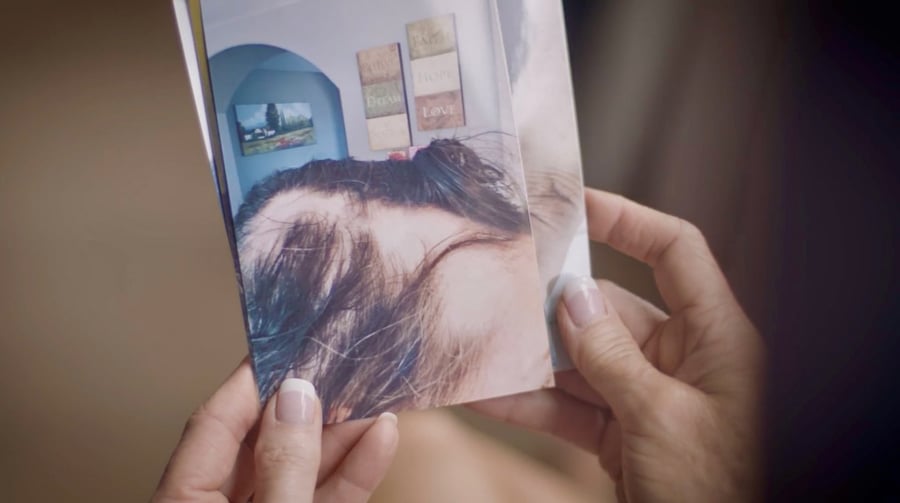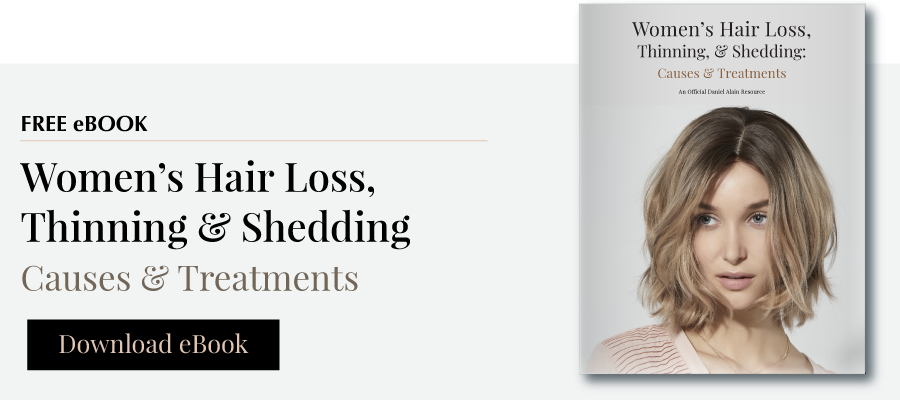Five Tips for Dealing With Alopecia

If you, or someone you love, has recently been diagnosed with alopecia, you probably have some questions about this disease. While facing any new diagnosis may feel frightening and uncertain, learning about alopecia and researching tips to help you deal with losing your hair, can help you feel more in control and confident in your ability to face this challenge.
Daniel Alain discusses the realities of alopecia, the treatments and possible cures, as well as our top five tips for learning to deal with alopecia-related hair loss.
With our 360-degree approach to hair loss that includes testing, treatments, and solutions, we are leaders in the industry and have worked with countless customers who have faced an alopecia diagnosis. We’re dedicated to addressing hair loss issues by providing straightforward, no-nonsense information on a range of subjects to help you feel more informed about your choices.
What is alopecia?

Alopecia is a medical term used to describe a condition characterized by partial or complete hair loss in specific areas of the body or, in some cases, all over the body. It’s most commonly associated with hair loss on the scalp, but it can affect other areas, including the eyebrows, eyelashes, and body hair.
Alopecia can manifest in various forms, and there are different types of alopecia, including:
Alopecia Areata: This type involves sudden and often patchy hair loss. It is an autoimmune condition where the immune system mistakenly attacks hair follicles.
Androgenetic Alopecia: Also known as male or female pattern baldness, this is the most common type of hair loss. It typically occurs gradually with age and is influenced by genetic factors.
Alopecia Totalis: This condition results in the complete loss of hair on the scalp.
Alopecia Universalis: This is the most severe form, leading to the complete loss of all body hair, including scalp, eyebrows, and eyelashes.
Scarring Alopecia: This type involves the destruction of hair follicles, often due to inflammation or scarring, leading to permanent hair loss.
What causes alopecia?
The exact cause of alopecia can vary depending on the type, and it may involve a combination of genetic, hormonal, and environmental factors.
How to treat alopecia?
Treatment options for alopecia depend on the type and severity of the condition. They may include medications, topical treatments, hair transplants, and lifestyle changes. Results from these interventions will vary from person to person.
Can alopecia be cured?

The possibility of curing alopecia depends on the specific type of alopecia and its underlying causes. Here’s a breakdown of the potential for a cure for the different forms:
Alopecia Areata: While there is no guaranteed cure, some people experience spontaneous regrowth of hair without treatment. Treatment options include medications like corticosteroids, topical immunotherapy, and biologic drugs, which can help induce hair regrowth in some cases. However, these treatments may not work for everyone, and the condition can be unpredictable.
Androgenetic Alopecia: While it may not be completely curable, there are treatments available that can slow down or partially reverse hair loss. Medications like minoxidil and finasteride, as well as hair transplant procedures, can be effective for some people.
Alopecia Totalis and Alopecia Universalis: These severe forms of alopecia can be challenging to treat. While there are treatment options like immunosuppressive drugs and therapies, they may not provide a cure for everyone, and responses to treatment can vary greatly among individuals.
Scarring Alopecia: The potential for a cure depends on the cause of scarring alopecia. If the underlying cause, such as inflammation or infection, can be successfully treated and resolved, hair regrowth may be possible. However, if the hair follicles are permanently damaged or replaced by scar tissue, a complete cure may not be achievable.
Tips for dealing with alopecia
Dealing with hair loss associated with alopecia can be tricky, especially if you’re seeking a cure that’s not guaranteed. Let’s outline our top five tips for dealing with alopecia.
Tip #1: See a dermatologist
Medical treatments are worth exploring before you give up hope of ever having a full head of hair again. Book in to see your dermatologist so that they can diagnose you appropriately and come up with a treatment plan that gives you the best chance of a positive outcome. While not all treatments are a success for everyone, knowing and understanding your type of alopecia will help you figure out which treatments are worth trying.
One of our customers, Kelly, suffers from androgenetic alopecia and sought attention from a scalp specialist. Unfortunately, treatments were not ultimately successful for Kelly, but, as she explains, “It was extremely important for me to pursue the medical side of things and to know that I had explored all my options, even though they weren’t able to help me.”
Tip #2: Care for your hair
Nurture the hair you have by treating it kindly. Do wash your hair with a gentle shampoo and moisturizing conditioner. Consider using a leave-in conditioner or detangler to keep it silky smooth and tangle-free. If you color or perm your hair, stop now! Avoid using any chemical treatment on your locks to preserve and maintain good hair health. Limit the use of hot tools such as a curling wand or straightening iron, and avoid wearing your hair tightly pulled back in a bun or ponytail. This kind of hairstyle puts strain on your hair and could cause it to shed further.
Tip #3: Find support (friends, family, groups)
Alopecia and hair loss may be overwhelming at times and it’s important to seek support from your friends and family. Leaning on the people you trust, sharing your insecurities and fears with them, and allowing them to be there for you when you really need them is what any loving friend or family member would want you to do.
One of our alopecian customers, Sally, relied on her husband to carry her through some of the most difficult and distressing times of total hair loss. “My husband has been my rock,” she explains. “He was truly phenomenal. I think it’s important for everybody to make sure they have that one person to lean on, because they can really help you get through this.”
Tip #4: Cover up
Hats and scarves are options people with alopecia may consider at some point in their journey. While some people proudly choose to celebrate their bald head and don’t feel the need to cover up, some people aren’t as comfortable with their new look, especially in the beginning. The decision to cover up or not is purely personal and nobody should feel pressured to conform to any certain look that doesn’t feel natural to them.

Similarly, not all people with alopecia will choose to wear a wig, but if it’s something that you’d like to explore, know that finding the right wig can bring a wealth of benefits to anyone experiencing hair loss.
How can a wig help someone with alopecia?
- A wig can help restore your confidence: Hair loss can have a significant impact on a person’s self-esteem and body image. Wearing a wig allows you to regain a sense of normalcy and confidence by providing a natural-looking head of hair.
- A wig can give you privacy and control: Some people with alopecia may prefer not to be asked questions about their hair loss. Wigs give people the control to decide when and how they want to reveal their hair loss.
- A wig can protect the scalp: As with hats and scarves, a wig will protect the scalp from harsh environmental elements such as sun exposure and cold weather, which can be uncomfortable for people with a sensitive scalp.
- A wig can support hair regrowth: For people waiting for their hair to regrow naturally, a wig is a temporary solution that allows them to maintain their look while they wait for their hair to return.
- A wig can improve mental well-being: Wigs can contribute to improved mental health and reduce the psychological impact of alopecia. They offer a solution for people who may feel self-conscious or distressed about their hair loss.
Tip #5: Be patient
Alopecia is unpredictable, and hair can take a long time to grow back, even when treatments are a success. Learning to be patient and leaning into the journey will help you face your challenges as they arise.
Sally was diagnosed with alopecia in her 20s but it wasn’t until she was in her mid-forties that it really impacted her life. And when it did, it was devastating. These days Sally is full of life and activity, but looking back, she describes her experience with alopecia as “a rollercoaster ride.”
Her best advice for someone going through something similar?
“There’s no book that can predict what’s going to happen to us in the next chapter, and so acceptance is the biggest thing,” she confesses. “Accept where you’re at and try to embrace it. Moving with the change is the best way to describe it.”

Do I want to explore Follea human hair wigs?
An alopecia diagnosis may be an overwhelming experience that makes you fear the future, but please know you’re not alone. Alopecia areata for example is estimated to affect almost 7 million people in the US alone, and people like our customers Kelly and Sally, share their real hair loss stories to help others benefit from their experience.
If you’re considering a human hair wig as a way to help cope with your hair loss and would like to know more about the Follea wigs we make and sell here at Daniel Alain, we encourage you to book an appointment with one of our consultants. Our consultations are free and private, and we’d be honored to help you navigate this journey and answer your questions about how a wig may impact your feelings about hair loss and alopecia.


.jpeg)
